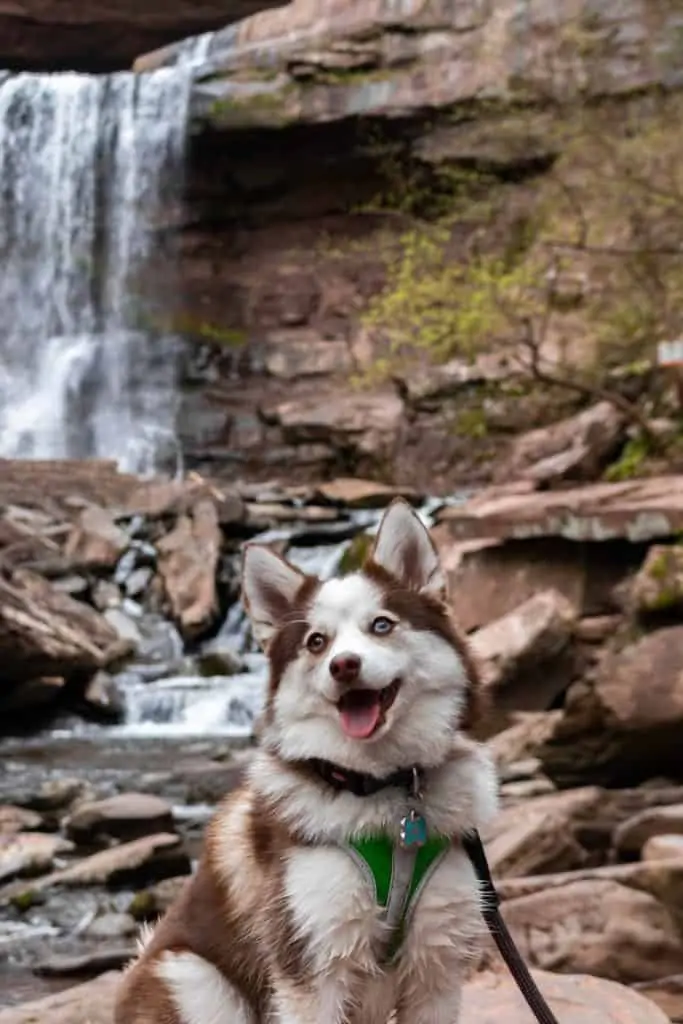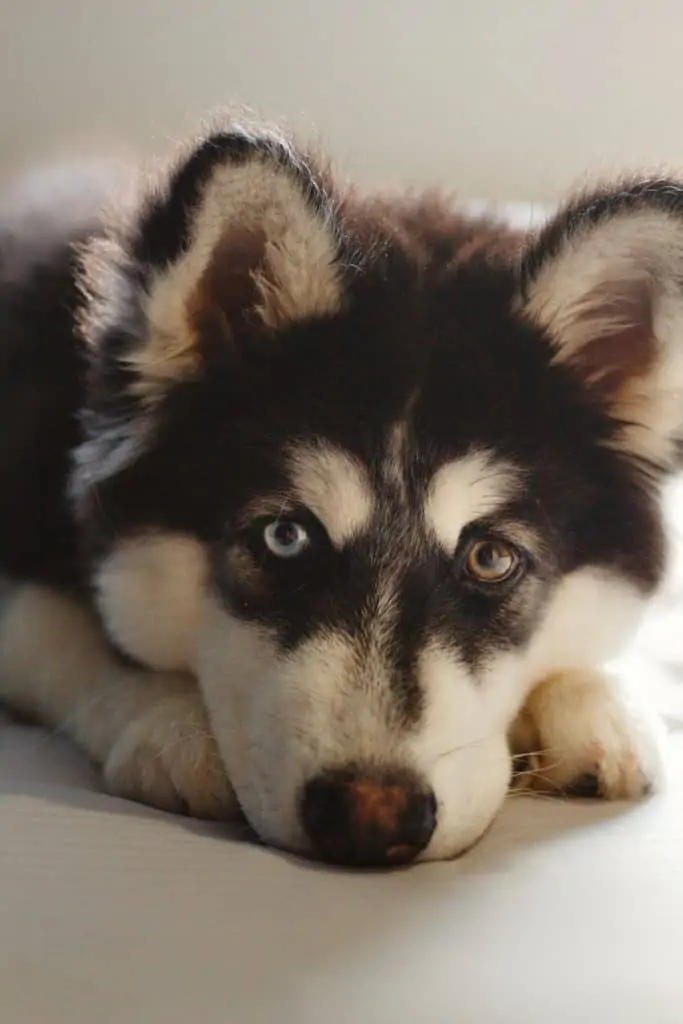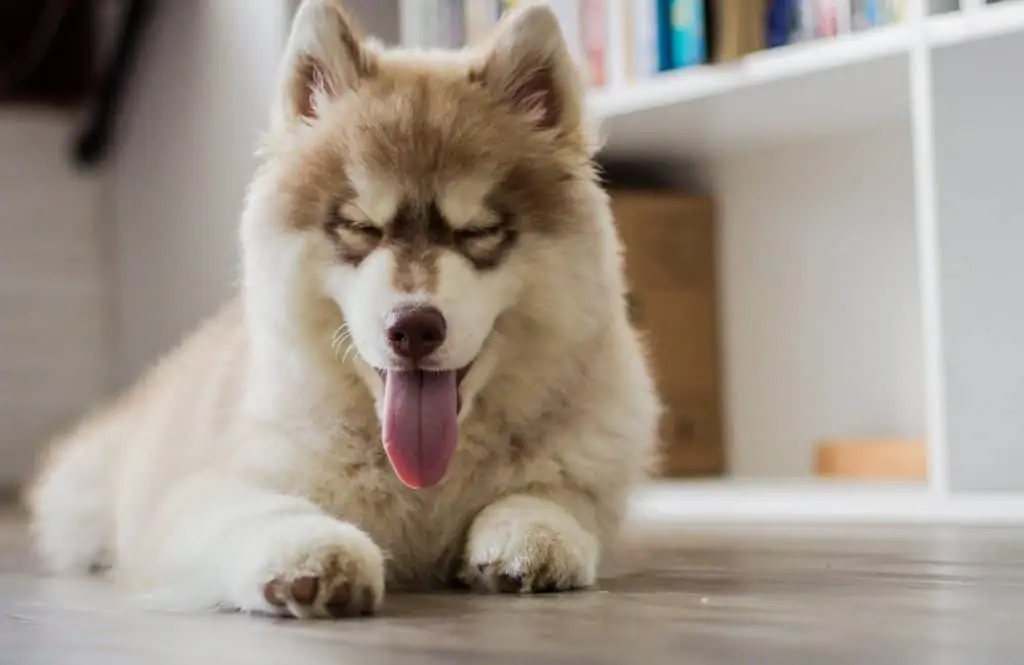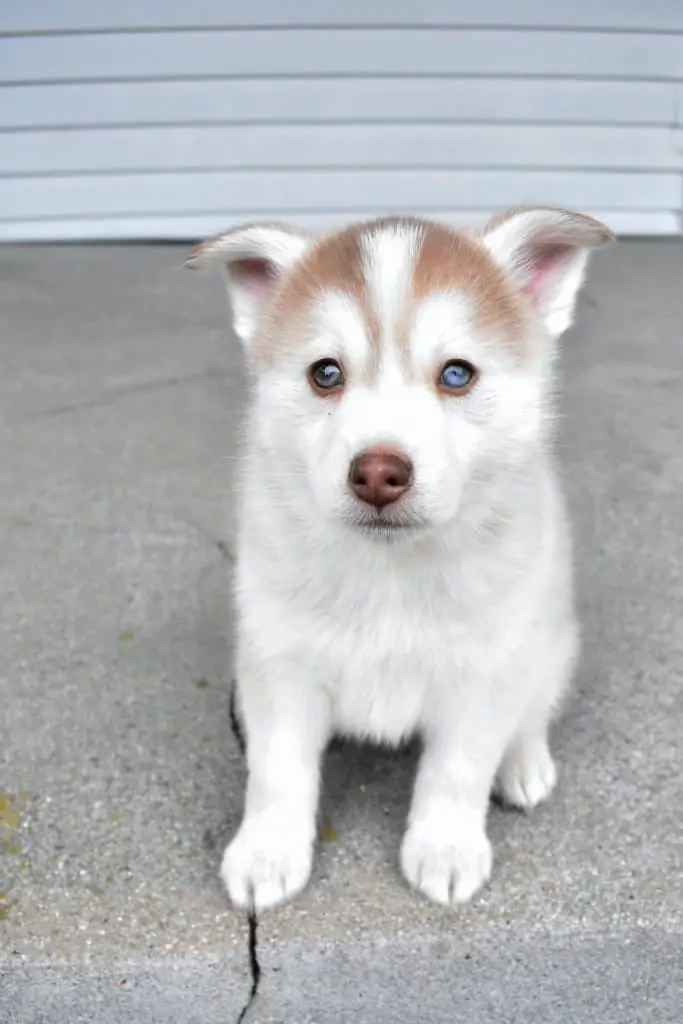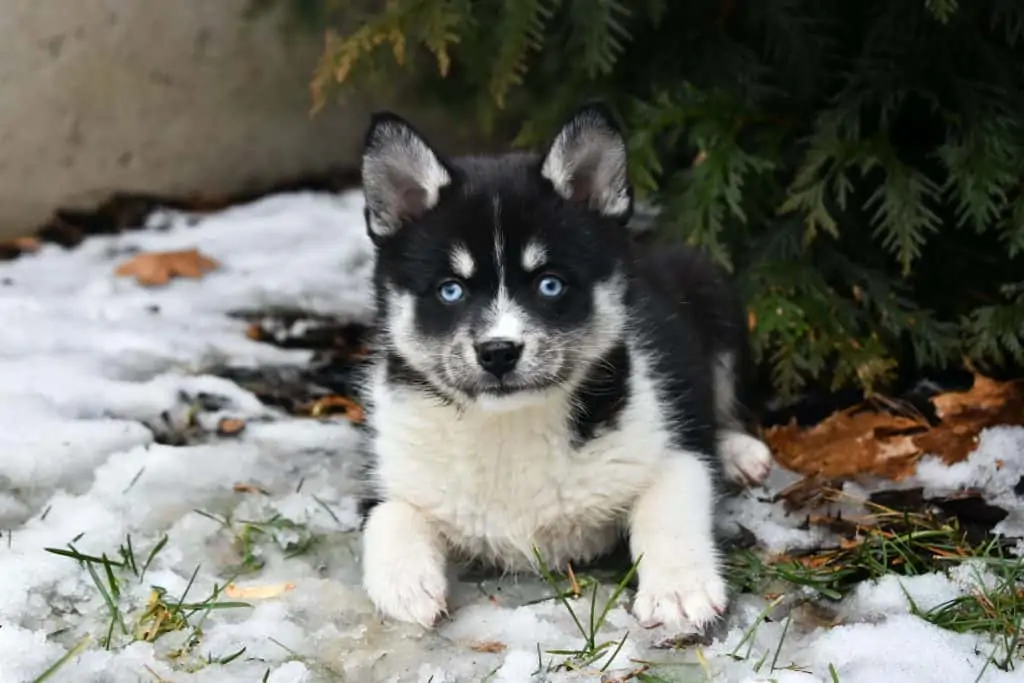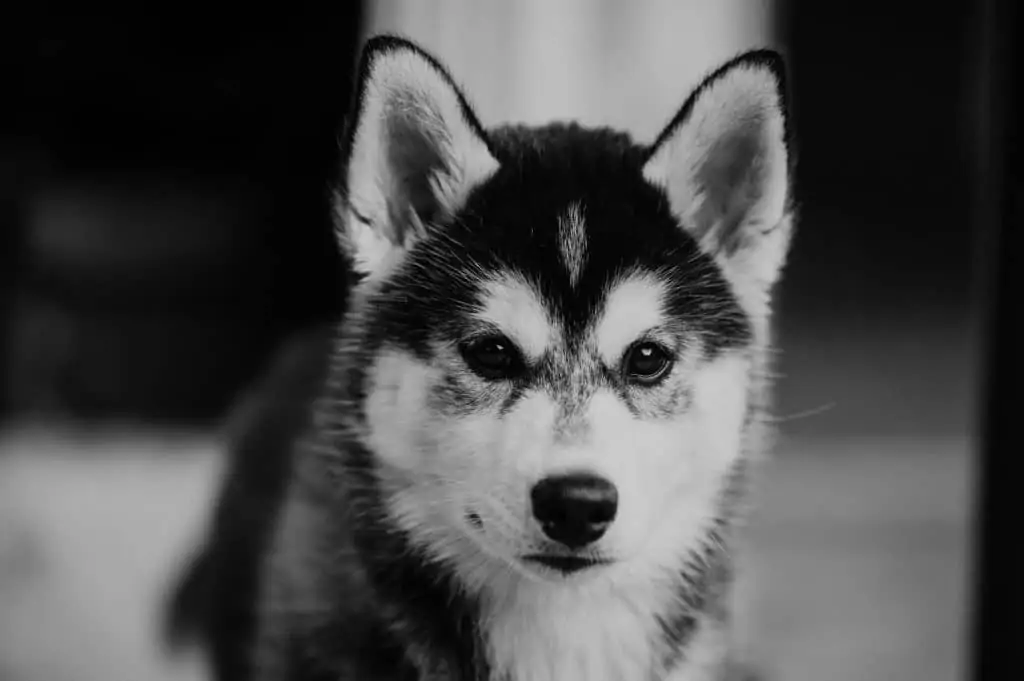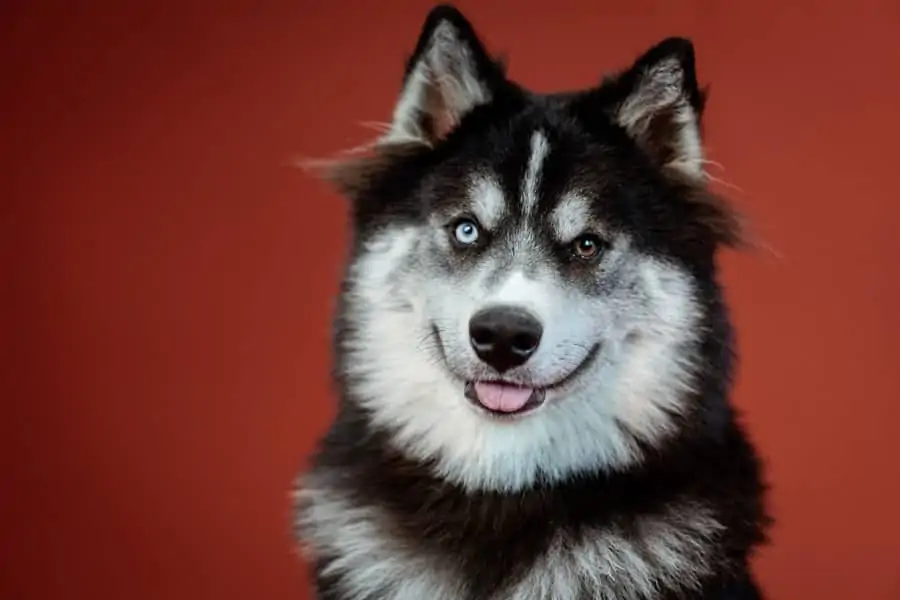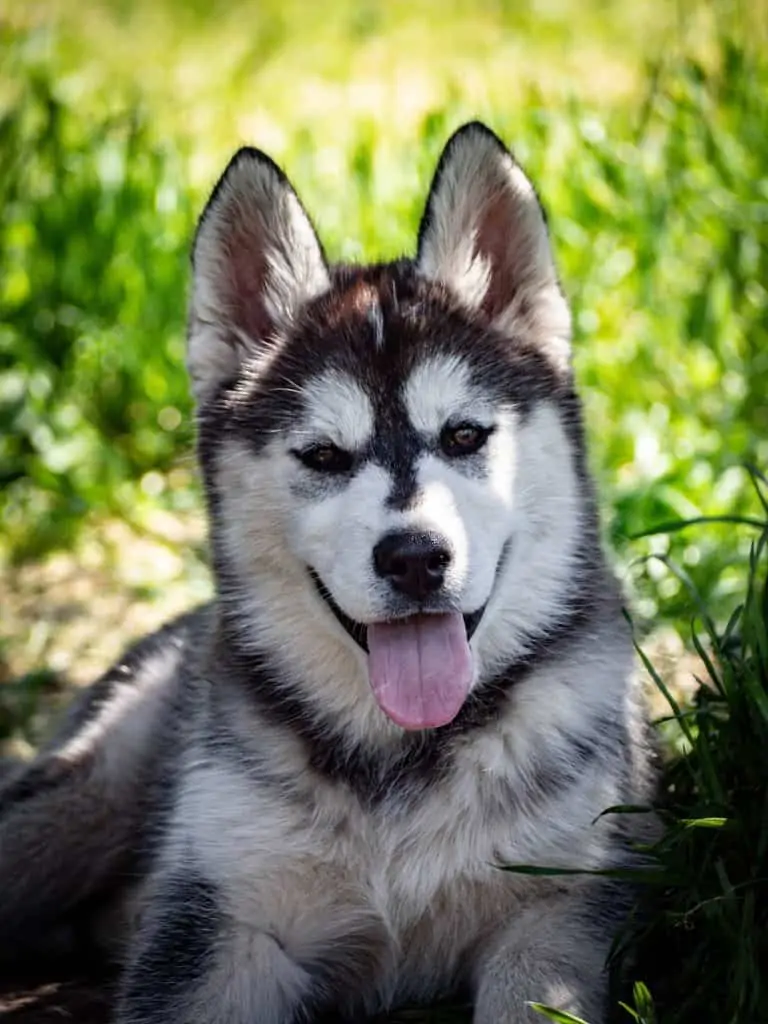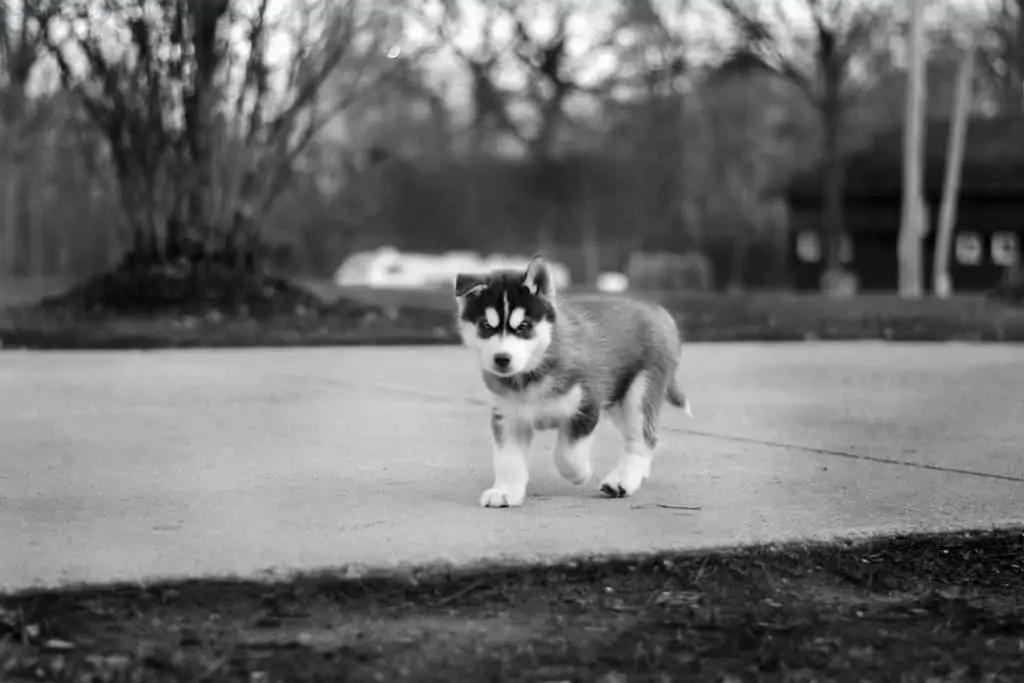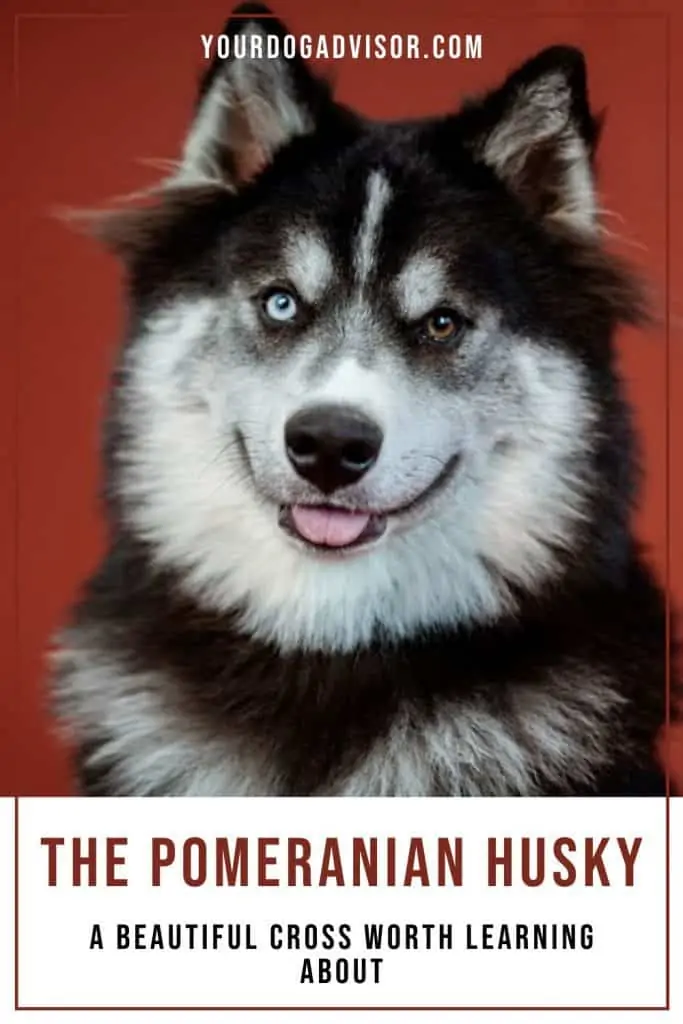A Spitz of a dog and a spitfire to boot, the Pomeranian Husky mix is everything an athletic, fun loving and experienced dog owner could hope for.
We love that this dog combines beauty and brains, and if you’re new to the Pomsky and need some tips and tricks on raising one, you’ve come to the right place.
Let’s begin.
Contents
What Is A Pomeranian Husky?
The Pomeranian Husky is a crossbreed and is the offspring of the Pomeranian and the Husky.
The Pomeranian Husky has the potential to be an overwhelming combination for the novice dog owner. That said, in the right hands the Pomeranian Husky can be your very best companion.
Intelligent and devoted, friendly and outgoing, this is a dog who thrives in family settings and with outgoing, consistent, and devoted owners.
But this is also a mixed beed that is a cross between two very active and outdoorsy purebred parents, and as a potential owner you should be prepared for the work this could entail.
You should also be prepared for the fact that, as a mixed breed, it can be difficult to establish just what your Pomeranian Husky puppy will grow up to look and behave like.
With that in mind, let’s take a quick look at the Pomeranian Husky Overview.
Temperament: Energetic, Outgoing, Playful, Affectionate
Average Height: 10 – 15 Inches
Average Weight: Between 20 and 30 Pounds
Coat Colors: Brown, red, reddish brown, blue, white, grey, brown, black, black and white, and a combination
Coat Types: Double-coated, long and shedding
Hypoallergenic: No
Life Span: 13 – 15 Years
Health Issues: Hip Dysplasia, eye issues, luxating patella, epilepsy, collapsed trachea, skin issues, heart disease, dental disease, and allergies
Average Pomeranian Husky Price: $500 – $5,000
Clubs That Accept The Pomeranian Husky:
Most major breed clubs like the American Kennel Club will not yet accept the Pomeranian Husky as a purebred dog. However, there are some relatively newer clubs established that specialize in this mix and they are working to get the hybrid established and recognized as his own breed.
One such club includes The American Pomsky Kennel Club.
But why won’t the American Kennel Clubs and other major breed associations accept the Pomeranian Husky Mix?
This is part of the crossbreed controversy. Keep reading.
An Overview Of The Crossbreed Controversy
There is some controversy surrounding the breeding and selling of hybrid dogs like the Pomeranian Mix.
Pomeranian Huskies, also sometimes known as Pomskies, are adorable dogs who look like bred down versions of the Husky.
A mix between the purebred Siberian Husky and the purebred Pomeranian, the Pomeranian Husky is considered a crossbreed. Also known as a hybrid, designer dog or mixed breed, crossbreed dogs fall somewhere between a mutt and a purebred.
Still, there are those who think they should be considered mutts while others insist Pomsky dogs are due to be recognized as purebreds in their own right. Unfortunately, this is a debate that has been ongoing for the past few decades.
While crossbreeding is a practice that has been ongoing for centuries, it actually takes generations of crossbreeding and perfecting a dog to ensure his bloodline is pure and that his traits are predictable.
We should note here that there are different generations of crossbreed dogs available, often categorized by the generation in which they were bred.
For example, if you obtain a Pomeranian Husky mix that is a first generation crossbreed, this means that one of his parents was a purebred Husky and the other was a purebred Pomeranian.
If you land yourself a second generation Pomeranian Husky, this means that your puppy’s parents are both first generation Pomeranian Husky mixes. And this can go on and on.
The later generation your Pomeranian Husky mix is, the more predictable many of his traits will be.
Still, even then it’s important to understand that the Pomeranian Husky, being a newer crossbreed, will still have genetic traits that could be left up to chance. This is especially true when it comes to appearance, health and temperament.
Luckily, both the Pomeranian and the Husky are known as playful, friendly dogs who do well with children and other pets, so it’s likely their Pomsky offspring would be just as loveable.
And with that in mind, let’s learn more about the Pomeranian Husky dog’s temperament and personality traits.
The Pomeranian Husky Temperament
Pomeranian Husky dogs are friendly and athletic.
While we can’t say for certain what kind of temperament your Pomeranian Husky will have, there are some average traits that this dog maintains that owners can prepare for.
For the most part, the Pomeranian Husky is a friendly, athletic and outgoing dog that typically gets along well with children, adults, strangers and other pets. Both the Pomsky’s parent breeds belong to the Spitz category, which means they are by nature athletic, work-oriented, and super fluffy.
As working dogs, the Pomeranian and the Siberian Husky enjoy staying active. And while their Pomsky offspring is generally a medium sized breed, he can be just as active as his Husky parent and just as clever as his Pomeranian parent.
The Pomeranian Husky mix will do best in homes with experienced dog owners or dog enthusiasts who understand working breeds. This is because, without the proper commitment and preparation, Pomeranian Husky dogs have been known to be somewhat overwhelming for owners.
The Pomeranian Husky Training Requirements
Training your Pomeranian Husky at an early age can help get him started on a path to a happy life.
Training is a must with the Pomeranian Husky. Without proper training, this is a hybrid who could be prone to a long list of serious behavioral issues, which is one of the reasons Huskies and Husky mixes so often wind up in shelters.
The good news is that if you start early, you’re certain to raise a happy and well-mannered Pomeranian Husky mix.
Begin training as early as possible and be consistent with your Pomeranian Husky. These are very intelligent dogs who enjoy learning new tricks and cues, although they can be prone to stubborn behaviors.
They will not be good listeners if they haven’t been properly exercised, so be sure your Pomeranian Husky is exercised before you try and utilize training. We also recommend beginning in enclosed spaces like a backyard or inside your home to teach your Pomeranian Husky basic cues and how to focus on you before taking him out into the real world.
Pomeranian Husky dogs will also not do well with training if the sessions are boring. They can become easily distracted, so to keep them engaged it’s a good idea to use quality treats, lots of praise, and take lots of breaks.
Avoid punishing or scolding your Pomeranian Husky during training. These dogs are more likely to shut down with negative reinforcement and have been shown to respond much quicker to positive reinforcement techniques.
It also helps if you use high value treats, like those listed below.
Buckley Trainers Training Treats
No products found.
Using specific treats during training can help keep your Pomeraniain Husky engaged and focused, especially if these treats are high quality, super smelly, and highly palatable.
One brand of treats we love for dogs is by the Buckley Store. These training treats are grain free, small, and available in several different flavors like bacon, peanut butter, chicken and salmon. This means you can choose the flavor your dog loves to ensure he is happy and engaged during training.
We also love that these treats are made with natural ingredients and are designed to be gentle on dogs with sensitivities and allergies.
Don’t Forget The Importance Of Socialization
Socialization should begin as early as possible and continue throughout your Pomeranian Husky’s life.
All dogs require proper socialization beginning at an early age to reduce potential behavior problems, especially active and intelligent dogs like Pomeranian Husky mixes. Without proper socialization, your Pomeranian Husky is at risk of suffering from serious anxiety, depression, stress and even fear-based aggressive tendencies.
Socialization is the act of ensuring your puppy or rescue is properly introduced to new experiences. These experiences could include meeting new people or children, going to different places, experiencing loud sounds, and being around other dogs.
Of course, very young puppies will need to be properly vaccinated before true socialization can begin, but you can start socializing them at a safe distance by taking them for car rides, helping them get used to crates, and introducing them to sounds like the vacuum running or the doorbell ringing.
When properly socializing your Pomeranian Husky mix, try and ensure that first impressions are positive for him. Avoid forcing your Pomeranian Husky mix to do things he is clearly fearful of doing, as this will only exasperate the fear and could lead to future behavioral issues.
If you plan on raising your Pomeranian Husky around children, it’s important to ensure your Pomeranian Husky mix is used to being handled by youngsters. Work on resource guarding behaviors by handling his food, treats and toys often, and get him accustomed to being touched on sensitive places like his nose, ears and paws.
It’s also a good idea to teach children the respectful and kind ways to interact with the family dog. Going over basic canine body language with your family will not only help reduce potential behavior issues with your Pomsky, but it can also help encourage bonding.
Last, be sure to monitor very young children around your Pomeranian Husky. Even the best trained dogs can growl, nip or bite if they are handled too roughly. Sadly, young children who are not yet aware of boundaries are often the most common victims of a dog bite, so keep this in mind.
How To Ensure Your Pomeranian Husky is Kept Exercised and Mentally Stimulated
Keeping your Pomsky mentally stimulated is just as important as keeping him physically stimulated.
Exercising any dog is important, and it’s especially important for an energetic and outgoing dog like the Pomeranian Husky mix. These dogs come from working stock and require plenty of routine exercise each and every day in order to stay happy and healthy.
Without the proper exercise routines, Pomeranian Husky dogs could potentially become destructive, depressed, anxious and develop behavioral issues like howling, whining, chewing and marking.
On the flip side, if you do keep your Pomeranian Husky routinely exercised, this dog should be calm and mild-mannered when inside the home.
Proper exercise for a Pomeranian Husky could include routine walks each day. Experts recommend a good hour walk in the morning, but if you have a particularly energetic Pomeranian Husky mix, you might consider two hour long walks broken up twice a day.
Ensuring you have the proper equipment is key to ensuring your walks go smoothly. Because they are so athletic, Pomeranian Husky dogs could become pullers if walked on the wrong leash and harness.
While some owners consider choke collars and prong collars to be the answer to pulling dogs, most experts agree that using no pull front clip harnesses or head harnesses are much more effective and much less dangerous.
BARKBAY No Pull Dog Harness
No products found.
We’re major fans of no pull harnesses like the BARBAY harness listed above because these harnesses include both front and back clip options for easier walking. The above harness can also be used for jogging, hiking, or even simple routine walks.
It reduces pulling without putting pressure on your Pomeranian Husky’s trachea, which can help reduce potential health issues down the road and makes walking more comfortable and safe for everyone.
Along with routine exercise, it’s also important to implement mental stimulation. Like all working breeds, the Pomeranian Husky mix is happiest when he feels useful and is given a job do.
You can train your Pomeranin Husky to help with certain chores around the house, or you can simply offer him puzzle toys to challenge him like the Nina Ottosson Puzzle Toy below.
Outward Hound Nina Ottosson Puzzle Toy
No products found.
Puzzle toys are a great way to help keep your Pomeranian Husky engaged and happy, especially if you’re going to be busy during the day. The above puzzle toy is one of our favorites because it is paint-free and made of dog-safe materials.
It also comes in different difficulty levels so you can level up or down depending on your dog’s abilities. The toy is designed to hold and hide treats or kibble, which will help keep your Pomeranian Husky’s attention.
Tips And Tricks For Grooming A Pomeranian Husky
Pomeranian Husky dogs have thick, double coats that require a bit of upkeep, though not as much as you may think.
The Pomeranian Husky has an incredible coat. And while this is one of his most stunning features, it can also be a bit overwhelming at first glance to those who are considering grooming.
However, while the Pomsky does require routine grooming to look his best and stay healthy, the maintenance that comes with this dense double coat is actually pretty low.
In fact, these dogs have coats that are considered weather resistant, which means they don’t hold water and are relatively self-cleaning. Pomeranian Husky dogs therefore do not need to be bathed too often, and in fact bathing them too often could even lead to skin and coat issues.
Instead, you’ll only need to bathe your Pomsky once every few months unless he gets into something particularly nasty.
His coat also works as a natural insulator against the elements, which means it can protect him from both the cold and the heat. For this reason, it’s important not to shave your Pomsky’s coat, even if you are attempting to keep him cool.
Shaving a dog’s double coat could actually put them at higher risk of serious health issues like heat stroke, sunburn, hypothermia and hyperthermia.
While Pomeranian Husky dogs don’t require too much bathing and don’t need haircuts, they are heavy shedders. They shed year-round and shed the heaviest during the shedding season, which is in spring and fall. Since they shed, they will require routine brushing with proper grooming tools like a deshedding comb and an undercoat rake.
Furminator Grooming Rake
No products found.
A grooming rake like the one above by Furminator is designed to get into your dog’s undercoat and remove loose hair and debris. It also helps to detangle any mats and reduce doggy odor while promoting healthy skin and coat.
The brush includes rotating metal teeth that are rounded at the end and will not harm your dog’s skin.
Pet Grooming Brush By Pet Neat
No products found.
We also recommend a deshedding brush that reduces loose hair. The above brush by Pet Neat promises to help reduce shedding by up to 95%, which can help not only keep loose fur off your furniture and clothing, but also from building up on your dog.
It is designed to increase overall coat and skin health and is made of stainless steel so it shouldn’t break or bend. There is also a button attachment that makes the brush self cleaning so you can brush and release the hair to speed up the process.
Along with routine brushing, your Pomeranian Husky mix should also have his nails trimmed often to keep them from breaking, his ears cleaned regularly to help prevent ear infections, and his teeth brushed daily to keep dental disease at bay.
The Most Common Health Issues And Average Lifespan Of A Pomeranian Husky
The Pomeranian Husky, like all dogs, can suffer from some genetic health issues owners should be aware of.
Have you ever heard of hybrid vigor? If so, you probably already know there is some debate surrounding the idea that crossbreed dogs like Pomeranian Huskies are healthier than purebred dogs.
This is due to the fact that mixed breed dogs have a wider gene pool than that of their purebred counterparts. Since purebred dogs have often been inbred over generations in order to maintain breed standards, they can be more at risk of hereditary diseases and deformities.
Crossing two different breeds reduces the chances of their offspring developing certain health issues and can even help increase life expectancy.
However, genetics are genetics and there is no guarantee that just because you have a crossbreed, that your crossbreed will be healthier and more long-lived than a purebred dog.
Furthermore, your Pomeranian Husky could also be prone to both of the common genetic health issues of his purebred parent breeds.
With that in mind, let’s take a look at the potential health issues of a Pomeranian Husky dog.
With a lifespan of between 13 and 15 years, the Pomeranian Husky can suffer from:
- Eye Issues
- Hip Dysplasia
- Luxating Patella
- Epilepsy
- Heart Disease
- Skin Issues
- Collapsed Trachea
- And Allergies
Compared to many other breeds and hybrid dogs, the above health issues a Pomsky dog could face is relatively short. That said, some of the issues on the above list could be serious.
They could also be compounded if you obtain your Pomeranian Husky through an irresponsible source like a backyard breeder or online seller, or if you do not keep up with routine vet visits, grooming, exercise, or a healthy diet.
Routine Vet Visits
Once upon a time, dog owners used to only take their dogs to the vet when they were sick or injured. Today, all of that has changed. We now know more than ever about preventative care and medicine, and how keeping up with wellness visits can help ensure our dogs live their best lives for as long as possible.
Most vets recommend that dogs under the age of seven visit routinely once a year. Dogs over the age of seven should be seen at least twice a year or every six months.
Doing this will not only help improve your Pomeranian Husky’s quality of life, but it can even save you money in the long run when it comes to health care and unexpected health issues.
Proper Grooming
Grooming your Pomernain Husky is about so much more than keeping him looking fly. Properly grooming your dog on a routine basis helps give you a hands-on look at your dog’s body.
It allows you to look out for any subtle changes, lumps, bumps, wounds or rashes you may otherwise miss on your dog, ultimately catching issues early before they could potentially become serious.
Exercise and Diet
Just like exercise and diet are important for you, they are also important for your Pomeranian Husky mix. Keeping your Pomsky active will help reduce potential health issues like obesity and joint problems as he ages. It will also help ensure he has a healthy mind.
And of course, diet is imperative to your Pomskies overall wellbeing. Try and ensure that your Pomeranian Husky is eating a quality dog food that is specified for his age, weight and activity level.
Steer clear of dog foods that contain additives, by-products, fillers, corn, soy and wheat, and instead stick with dog foods that are rich in real animal meats, fatty acids, carbs, vitamins, and minerals.
Blue Buffalo Life Protection Dog Food
No products found.
We like Blue Buffalo. It’s no secret this is a high-quality brand made with high quality ingredients, but we especially like it for the Husky Pomeranian mix who need a bit of extra TLC when it comes to diet. This dog food is a high protein dog food specified for large breed adult dogs and is made with natural, holistic ingredients.
The recipes include chicken, fish or lamb and are made with healthy grains like brown rice. For the Pomeranian Husky, we recommend choosing the fish or lamb recipes, as poultry can sometimes lead to digestive and skin issues in dogs with allergies.
This dog food also includes Omega 3 and Omega 6, which help promote a strong immune system and coat.
Should You Rescue Or Buy? How To Choose The Best Pomeranian Husky Mix For You
Buying from a reputable breeder may ensure you get a healthier Pomsky, but going through a rescue has just as many benefits you may be unaware of.
Bringing a new puppy or rescue into your home is always a fun and nerve-wracking experience. There is so much to prepare for to ensure you and your puppy start off on the right foot!
Although you may be in a hurry to get your hands on that cute ball of fur, we encourage you to exercise some patience. Remember, the source from which you get your Pomeranian Husky can make all the difference in his quality of life in the long run. It can also impact your emotional health and your wallet.
So, should you buy from a breeder or go through a shetler? Let’s find out.
Going Through A Breeder
Reputable breeders tend to charge more for their Pomeranian Husky mix dogs. This price usually ranges from $500 all the way up to $5,000, though the average price is usually around $1,500 to $2,000 for a Pomsky pup.
This price will vary depending on your location, the breeder you go through and the gender of puppy you select, as oftentimes female puppies are a bit more costly.
Beware of breeders who are selling Pomsky puppies at prices too low or too high, and be sure to ask plenty of questions. Do some digging, and remember that reputable breeders will provide you with health certificates proving their puppies have been screened and cleared of any serious health issues.
Going Through A Rescue
Adopting a Pomsky has plenty of benefits that range from price to temperament. That said, there is still a cost of going through a reputable shelter.
On average, most shelters charge between $250 to $750 for adoption. This price often includes a free initial vet exam, behavioral testing, and other resources you may need to ensure you and our Pomsky start off on the right foot.
Dogs that come from shelters may also already be fixed, and many have even already undergone basic training and socialization.
Regardless of which source you go through to obtain your Pomsky, it’s important that you take your time when choosing the right Pomeranian Husky dog for you and your family.
Remember, these dogs are not the best dogs for everyone, and they require plenty of time, attention, training, socialization, commitment and love.
So, do you think the Pomernain Husky is the best dog for you and your family? Tell us what you think about this adorable hybrid in the comment section below.
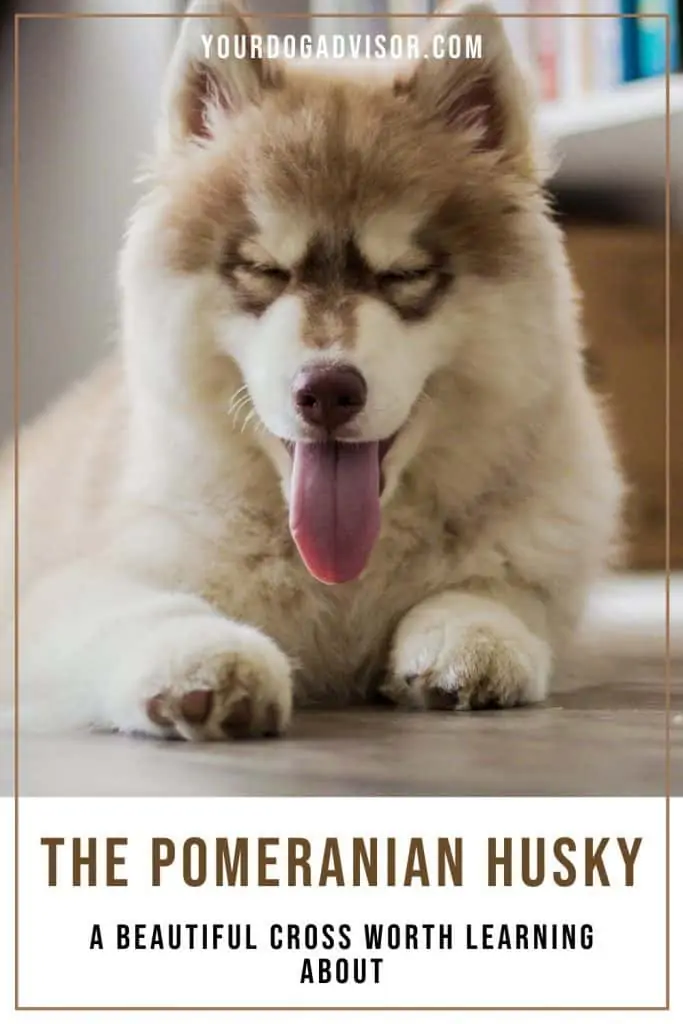

Jen Jones is a professional dog trainer and behavior specialist with more than 25 years of experience. As the founder of ‘Your Dog Advisor’ and the ‘Canine Connection’ rehabilitation center, she applies a holistic, empathetic approach, aiming to address root causes rather than merely treating symptoms.
Well known for her intuitive and compassionate approach, Jen adopts scientifically-proven, reward-based methods, encouraging positive reinforcement over punishment. Jen specializes in obedience training, behavior modification, and puppy socialization. Her innovative methods, particularly in addressing anxiety and aggression issues, have been widely recognized. Jen has worked with many of the world’s leading dog behaviorists and in her free time volunteers with local animal shelters and rescue groups.
